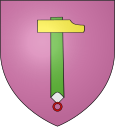Fleurey-lès-Faverney
| Fleurey-lès-Faverney | ||
|---|---|---|

|
|
|
| region | Bourgogne-Franche-Comté | |
| Department | Haute-Saône | |
| Arrondissement | Vesoul | |
| Canton | Port-sur-Saône | |
| Community association | Terres de Saône | |
| Coordinates | 47 ° 45 ' N , 6 ° 5' E | |
| height | 210-368 m | |
| surface | 11.29 km 2 | |
| Residents | 466 (January 1, 2017) | |
| Population density | 41 inhabitants / km 2 | |
| Post Code | 70160 | |
| INSEE code | 70236 | |
Fleurey-lès-Faverney is a commune in the French department of Haute-Saône in the region Bourgogne Franche-Comté .
geography
Fleurey-lès-Faverney is located at an altitude of 258 m above sea level, seven kilometers north-northeast of Port-sur-Saône and about 15 kilometers north-northwest of the city of Vesoul (as the crow flies). The village extends in the central part of the department, in an elevated position on the edge of the plateau south of the Lanterne valley and east of the Saône .
The area of the 11.29 km² municipal area includes a section in the area of the upper Saône valley. The western part of the municipality is occupied by the Lanterne valley floor. The alluvial low lies on average at 215 m and has a width of around three kilometers. Former sand and gravel pits north of the lantern are filled with water and are used for water sports. The community area extends to the edge of the vast Bois des Balières forest .
To the east, a 30 to 40 m high step leads over to the adjacent plateau of Fleurey, which consists of an alternating layer of sandy-marl and calcareous sediments from the Middle Jurassic . Older layers of the Lias ( Lower Jurassic ) also emerge at the foot of the slope . The plateau is divided by the valley cut of the Ruisseau de l'Étang , which flows into the Lanterne below Fleurey. The northern end of the plateau is formed by the heights of La Roche (314 m) and La Croix d'Argent (326 m), which drop steeply to the Lanterne valley. Agricultural use predominates on the plateau. Further to the east, the communal soil extends into the wooded heights of the Bois de Breurey , where at 368 m the highest point of Fleurey-lès-Faverney is reached.
Neighboring municipalities of Fleurey-lès-Faverney are Faverney in the north, Breurey-lès-Faverney and Provenchère in the east, Villers-sur-Port in the south and Amoncourt and Conflandey in the west.
history
The area around Fleurey was already settled in prehistoric times. The village was first mentioned in the 12th century under the name Floriacus in the chronicle of the Bèze monastery. In the Middle Ages, Fleurey belonged to the Free County of Burgundy and in that part of the Bailliage d'Amont area . The Faverney Monastery held jurisdiction over the village. In 1638 Fleurey was hit by a plague epidemic. Together with Franche-Comté , the village finally came to France with the Peace of Nijmegen in 1678. In the 18th century iron ore was mined in the area. With the opening of the tram from Faverney to Amance in 1911, Fleurey-lès-Faverney was connected to the public transport network. However, the line was stopped again in 1938. Today Fleurey-lès-Faverney is a member of the communal association Communauté de communes de la Saône Jolie, which comprises 16 towns .
Attractions
The Saint-Maurice church was rebuilt around 1740. The furnishings from the time of construction include a richly carved wooden altar, grave slabs and paneling. The rectory dates from the 18th century.
In the area of the village there are four Calvaires , including the Calvaire de Saint-Roch .
Only a few remains of a medieval castle are visible.
population
| Population development | |
|---|---|
| year | Residents |
| 1962 | 422 |
| 1968 | 431 |
| 1975 | 402 |
| 1982 | 393 |
| 1990 | 411 |
| 1999 | 365 |
| 2006 | 394 |
With 466 inhabitants (January 1, 2017), Fleurey-lès-Faverney is one of the smaller municipalities in the Haute-Saône department. Throughout the 20th century, the population ranged between 310 and 460 people and showed several fluctuations.
Economy and Infrastructure
Until well into the 20th century, Fleurey-lès-Faverney was primarily a village characterized by agriculture (arable farming, fruit growing and cattle breeding) and forestry. Today there are some local small businesses, including in the wood processing and construction industries. In the last few decades the village has transformed into a residential community. Many employed people are therefore commuters who work in the larger towns in the area and in the agglomeration of Vesoul.
The village is located off the major thoroughfares near a departmental road that leads from Vesoul to Faverney. Further road connections exist with Amoncourt and Port-d'Atelier-Amance.
